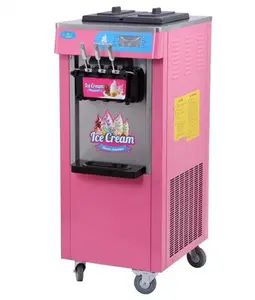
All categories
Featured selections
Trade Assurance
Buyer Central
Help Center
Get the app
Become a supplier

(64150 products available)














































A batch freezer is a simple ice cream machine that works well when making small batches. It cools down the mix while churning to make ice cream. The ice cream maker can be a direct expansion or be kept cold with salt-ice. A direct expansion freezer uses a refrigerant in the mixing can to make ice cream, while a salt-ice freezer uses a brine solution to cool the mixing can. This type of ice cream making machine is best for small ice cream shops.
An ice cream machine with a heat exchanger and continuous freezer is more advanced. It has a heat exchanger that cools the mix before freezing, and it also churns and freezes the mix as it moves through. The ice cream is then constantly pumped out. This equipment works well for large-capacity ice cream production. Ice cream factories mostly use it because it can quickly make ice cream of the same texture and temperature.
Whipping air into ice cream is important to give it body and smoothness. An aerator adds the right amount of air before the ice cream is frozen. The amount of air in ice cream is called overrun. Overrun makes ice cream lighter and helps it stay fresh for a longer time. Using an aerator keeps the overrun steady.
The pasteurizer cools the ice cream mix to a specific temperature after it has been heated. This mix is then stored until the ice cream is ready. Cooling the mix prevents harmful bacteria from growing. Ice cream made from unpasteurized mix can make people sick because the bad bacteria can cause stomach problems.
Ice cream making machines in factories often have a hardening tunnel to freeze the ice cream quickly after it has been made. In the hardening tunnel, the ice cream is put on a conveyor belt that moves through a very cold freezer. Quickly freezing the ice cream keeps the taste and stops ice crystals from forming.
Ice cream makers perform various functions, from stirring and mixing the ice cream base to adequately freezing and serving it. The following are the critical features of factory ice cream machines;
Ice cream is a popular dessert that people enjoy eating worldwide. However, because of its high demand, ice cream is in great supply, and consumers can buy it in different quantities. An ice cream production machine comes in handy when making ice cream on a large scale.
Ice cream can also be made at home. Nonetheless, ice cream factory machines are more convenient for mass production. There are different ways to use ice cream-making machines. The batch machines are useful in making ice cream in a single batch. To make soft-serve ice cream, direct-reading machines that provide instant output are more suitable. These kinds of machines are also efficient when making ice cream served in food chains, restaurants, or vending trucks. Pump machines can be used to store ice cream in cold-temperature tanks. They also have a refrigeration system to maintain the low temperature.
The kind of ice cream machine to be used is determined by the amount of ice cream to be produced, the power source, and the ice cream's texture. Using the right ice cream machine will help achieve the desired production output.
When opting for a method of ice cream production, a buyer or manufacturer needs to consider various factors that surround cost, durability, and functionality. The following are some of the considerations to make;
Q1: What type of packaging is used for ice cream in bulk?
A1: Ice cream is typically packaged in containers or tubs made of plastic or metal for bulk storage. These materials provide airtight seals that prevent freezer burn while protecting the product from contaminants. Additionally, they may feature insulation layers to maintain low temperatures during transportation and storage. Tubs come in various sizes, from a few liters up to several hundred liters, depending on the producer's needs.
Q2: How is the ice cream kept at low temperatures during transport?
A2: Special refrigerated trucks or containers are used to transport ice cream. These vehicles have built-in freezers that maintain constant low temperatures (-20°C to -25°C) required to keep ice cream solid. Before loading the ice cream, these trucks are pre-cooled to the proper temperature. Moreover, proper insulation in the vehicle prevents heat from entering, keeping the cold inside.
Q3: What safety rules are followed when making ice cream?
A3: There are several rules and guidelines to ensure ice cream is made safely. The FDA has regulations that cover things like the safe temperatures for pasteurizing milk and cream. Ice cream factories also need to have proper sanitary conditions to prevent contamination. These include cleaning machines and hands often, using food-safe materials, and keeping the production area clean. Additionally, ice cream must be made using specific quality ingredients.
Q4: How is quality checked during the ice cream-making process?
A4: Ice cream factories have quality control methods to make sure the final product is consistent and good. Measurements are taken to monitor things like temperature and mixing speed. These measurements help check that the production process is working correctly. Also, workers regularly check the ice cream's taste, texture, and appearance to ensure the quality is up to standard. They also examine the packaging to confirm it is sealed.